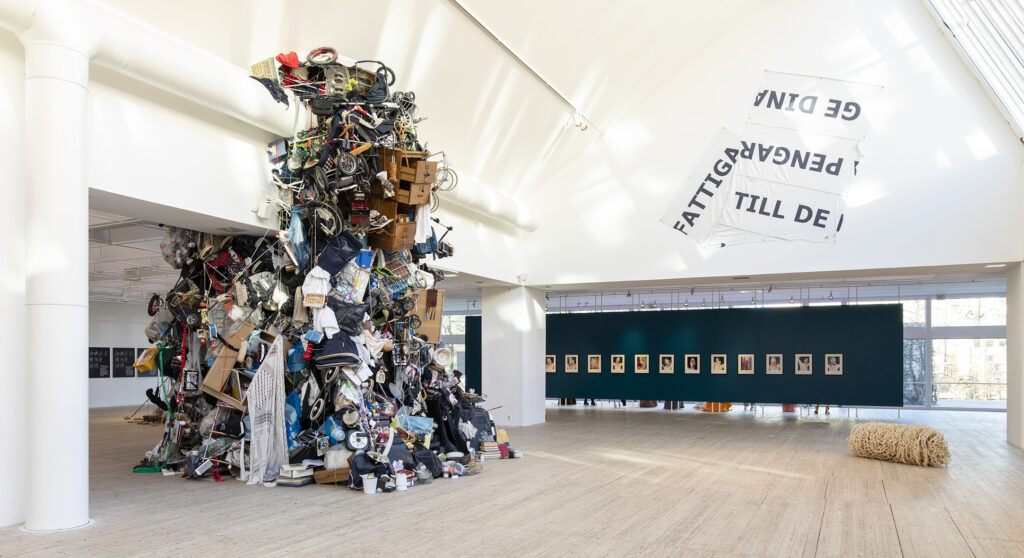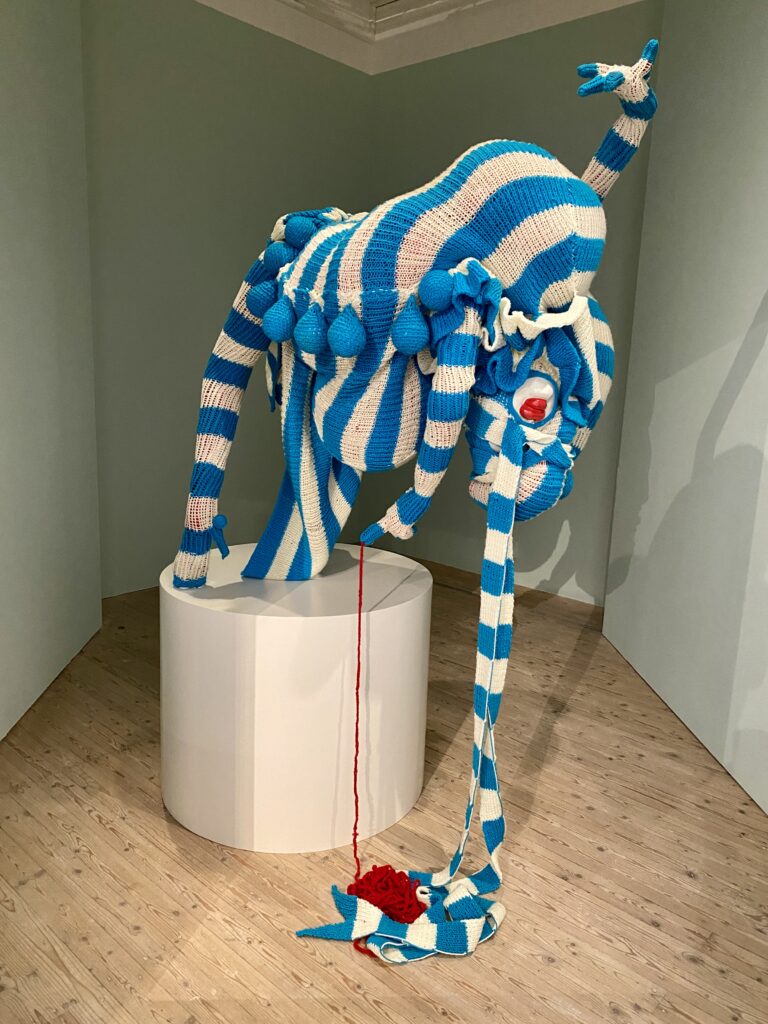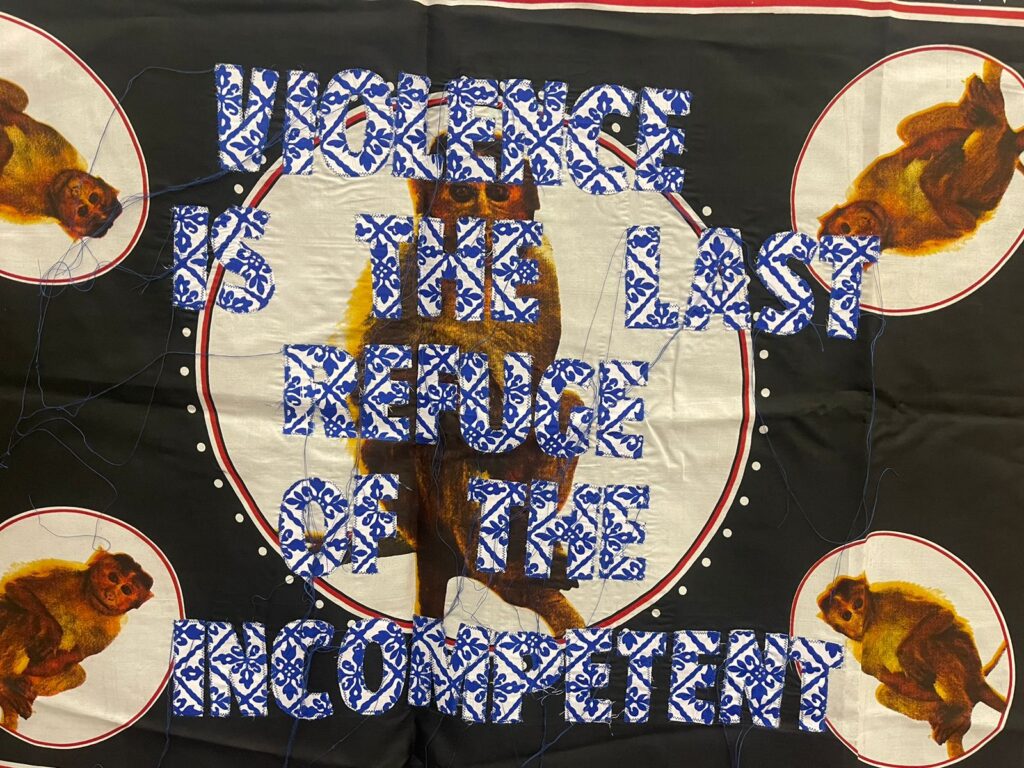
Guest artists of the exhibition
An important part of this exhibition is its food for thought, its nods to, appropriations of and starting points in other artistic practices. Therefore, a selection of Leif Holmstrand’s private collection, supplemented by work on loan, are shown in a separate section of the gallery. In this part of the exhibition, Holmstrand himself is the curator and refers to the selected artistic practices as guest artists, sources of inspiration, collaborators, idols, and reference artists.
Hans Bellmer (1902–1975) was a German surrealist working mostly in France and preoccupied with dark and sinister sexuality. Doll-like objects, sculptures, drawings, prints and photographic collages have together with his text production frightened and captivated for hundreds of years. An untitled print of Hans Bellmer is shown in the exhibition.
Leigh Bowery (1961–1994) was an Australian multidisciplinary artist with a focus on absurd clothing design and shocking performances. He died of AIDS just before the advent of viable antiretroviral drugs, but before that he managed to completely redraw the boundaries of what queer culture could be, consequently opening up new possibilities for art in general. Leigh Bowery is an important reference, especially for the costumes that are shown in the exhibition.
Chim↑Pom (2005) is an artist collective from Tokyo and one of the most successful Japanese artists of recent decades. They stand for a kind of playful, occasionally offensive, politicallyexplosive neo-Dadaism. Their works are generally action-based but result in objects, videos and installations. The exhibition screens the second version of Chim↑Pom’s video work “Black of Death” from 2013, where thousands of crows are lured from the radioactive no-go zone around the failed Fukushima nuclear power plant all the way down to central Tokyo.
Nan Embäck (1995) is a Malmö-based painter and sculptor who works within a bodilyseeking idiom beyond rationality. Nan Embäck’s sculpture “Mirror-Bright Skin” from 2022 is shown in the exhibition, and blends together the internalised with external perceptions.
Oscar Guermouche (1977) lives in Gårdby on Öland and uses his MENA-background alongside issues of masculinity, gender and language in often text-based conceptual artworks, realised as performance, video, objects, paintings, drawings and books. His career began with a so-called art union scandal in 2009, when he was accused of flag desecration. Oscar Guermouche’s text painting “Dean Koontz (Männerphantasien)” from 2010 is shown in the exhibition.
Majd Abdel Hamid (1988) is a Palestinian artist who makes politically poetic conceptual art, often utilising the field of traditional embroidery. He was born in Damascus and works in Beirut, Ramallah and Paris. Majd Abdel Hamid’s “Man Running (Two Screenshots)” from 2015 is one of an endless series of embroideries depicting public deaths in the MENA-region.
Lisa Jeannin (born 1972) uses radical imagination and serious play to uncover and process the world in the present and in memory, but above all, to build new and perhaps truer connections in a surreal reality. Sculpture, stop-motion animated video, drawing, and painting quickly follow one another and often coexist in total installations. She lives in Järna. “Siri Derkert” (2003), a hanging double-sided portrait of the well-known modernist artist colleague, is displayed by Lisa Jeannin.
Lunga Kama (1982) from Cape Town in South Africa is a photographer working with the bodily and the gendered in a beautiful and fragile way, often with clear roots in Hindu and Xhosa. Lunga Kama’s “Ubuntu Libhongo Lam / Humanity is my Pride”, from 2009, is shown in the exhibition.
Sachiko Kazama (1972) lives and works in Tokyo. She is a celebrated printmaker capable of working in astonishingly large formats, but even her smaller works have had success due to their inherent social critique and portrayal of detailed, absurd Kafkaesque worlds. Sachiko Kazama’s linocut “Puchi-Buru Kun” from 2013 is exhibited here.
Lawrence Lemaoana (1982) is a South African artist with a background as a rugby player. His textile wall hangings twist and turn masculinity and African self-image through the visual language of kanga cloth and do so with both sensitive humour and immense anger. Lawrence Lemaoana’s “Violence is the last Refuge of the Incompetent” from 2022 is shown in the exhibition.
Anna-Maria Neumüller (1971) does not often work as an artist but has for example exhibited a simultaneously alluring and abject pile of deep-fried high heels at Vita Kuben in Umeå and has collaborated with Leif Holmstrand in several happenings. She combines everyday material into absurd and assertive statements, poetic and concrete. She lives in Malmö. Anna-Maria Neumüller shows her work “Glassed High Heel” (1997) in the exhibition.
OLTA are a Japanese artist collective that work in a somewhat neo-shamanistic tradition manifesting in many different forms of artistic expression. They perform rituals, build sculptural props that sometimes coincide with stage costumes, make sound art, video works and so on. In 2015 they performed the work Fake Bones together with Leif Holmstrand at Lilith Performance Studio in Malmö. A plaster bone that was created by OLTA during the ten days performance ritual is exhibited here. OLTA also participates in the exhibition program with a live-streamed performance alongside Leif Holmstrand from Tokyo on April 28th.
Pyuupiru (1974) lives in Hachioji/Tokyo and made her first major impact at the 2005 Yokohama Triennial (Art Circus) with a large-scale installation and performance entitled Secret no. 1 – Love Reincarnation. The works revolved around her ongoing transition and sought to ceremoniously introduce a temporary non-gendered existence alongside stable possibilities for healing, realisation and love. Pyuupiru’s photographic self-portrait “Selfportrait #24 – A Demon Murderer Celebrating a Ritual” from 2007 and the costume/ sculpture “Planetaria – Mercury” from 2001 are displayed in the exhibition.
Meraj Sharifi (1990) is from Tehran, Iran, and lives in Copenhagen, Denmark. His work is often dedicated to LGBTQ identities and related freedom struggles. Sharifi works primarily as a graphic artist but often allows his artworks to span into other fields. In the exhibition you can see a small untitled drawing by Meraj Sharifi from 2021 depicting a red hand, which Leif Holmstrand previously used as an informal performance prop.
Lieko Shiga (1980) from Miyagi, Japan, unlocks the dreamlike qualities of the digital photograph. She has exhibited her work in prestigious venues such as the Mori Art Museum in Tokyo, MoMA in New York and the Beijing Photo Biennial. She is best known for the large-scale photographic installation work “Human Spring”, which very personally invokes the great earthquake and tsunami of 2011. Lieko Shiga’s work “Portrait of Cultivation” from the Rasen Kaigan series (2009) is shown in the exhibition.
Lotta Smed (1972) is an unusual Swedish sculptor and image-maker based in Lindesberg and Stockholm. Her sensual and perhaps absurd objects do not primarily seek to establish personal rational statements, but instead operate within the field of intuition where dreams, gender, transformations and desires share space. Lotta Smed’s untitled sculptural duet of coloured wax (2004) is exhibited here.
Fredrik Strid (1973) is a sculptor and installation artist, living in Persbo/Månkarbo. The recurring theme in his work is nature as a cultural product, corroded by memory and time. Strid runs a sculpture park at Persbo Studio and a residency programme. He has studied under Mary Kelly, worked as an assistant to Mark Dion, and taught at Konstfack in Stockholm. Fredrik Strid’s sculpture “Black Box” (shelf) from 2015 is part of the exhibition. The work is cast in blackened acrystal.
Per Wizén (1966) lives in Malmö and is renowned for his minute, quietly surreal collages with strong art historical and gay historical references. However, Per Wizén presents instead in this exhibition the sculptural object “Untitled (Spinning Top)” from 1998.
Sakiko Yamaoka (1961) is primarily a performance artist but also makes small drawings with a pyrography pen on paper. Her practice deals with the individual versus the collective, perception, time and so on, all inscribed in the body as motifs and means of expression. She lives in Kawagoe/Tokyo. An untitled pyrograph by Sakiko Yamaoka is shown in the exhibition, probably created in 2012.
Jonas Örtemark (1972) is an artist and author living in Gothenburg. He has collaborated with Leif Holmstrand many times, most recently with the extensive text project The Chasm, published by Rojal Förlag in 2021. For some time now, he has devoted himself to small, peculiar paintings with diffuse fairytale-like themes and dark undertones. Jonas Örtemark’s small mixed media work “Thought-Form: Intelligence Transported” from 2021 is exhibited.
Information
These artists and works are being showcased as part of the exhibition “Life of Termites: The End” at Malmö Konsthall


